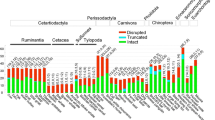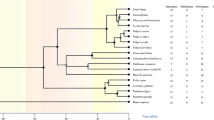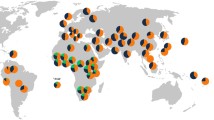Abstract
The sense of bitter taste plays a critical role in animals as it can help them to avoid intake of toxic and harmful substances. Previous research had revealed that chicken has only three bitter taste receptor genes (Tas2r1, Tas2r2 and Tas2r7). To better understand the genetic polymorphisms and importance of bitter taste receptor genes (Tas2rs) in chicken, here, we sequenced Tas2rs of 30 Sichuan domestic chickens and 30 Tibetan chickens. Thirteen single-nucleotide polymorphisms (SNPs) including three nonsynonymous mutations (m.359G >C, m.503C >A and m.583A >G) were detected in Tas2r1 (m. is the abbreviation for mutation); three SNPs were detected in Tas2r2, but none of them were missense mutation; eight SNPs were detected in Tas2r7 including six nonsynonymous substitutions (m.178G >A, m.421A >C, m.787C >T, m.832G >T, m.907A >T and m.943G >A). Tajima’s D neutral test indicates that there is no population expansion in both populations, and the size of the population is relatively stable. All the three networks indicate that red jungle fowls share haplotypes with domestic chickens. In addition, we found that haplotypes H1 and HE1 were positively associated with high-altitude adaptation, whereas haplotypes H4 and HE4 showed a negative correlation with high-altitude adaptation in Tas2rs. Although, chicken has only three Tas2rs, our results showed that both Sichuan domestic chickens and Tibetan chickens have abundant haplotypes in Tas2rs, especially in Tas2r7, which might help chickens to recognize a wide variety of bitter-tasting compounds.

Similar content being viewed by others
References
Adler E., Hoon M. A., Mueller K. L., Chandrashekar J., Ryba N. J. P. and Zuker C. S. 2000 A novel family of mammalian taste receptors. Cell 100, 693–702.
Behrens M., Foerster S., Staehler F., Raguse J. -D. and Meyerhof W. 2007 Gustatory expression pattern of the human TAS2R bitter receptor gene family reveals a heterogenous population of bitter responsive taste receptor cells. J. Neurosci. 27, 12630–12640.
Behrens M. and Meyerhof W. 2013 Bitter taste receptor research comes of age: from characterization to modulation of TAS2Rs. Semin. Cell Dev. Biol. 24, 215–221.
Campa D., De Rango F., Carrai M., Crocco P., Montesanto A., Canzian F. et al. 2012 Bitter taste receptor polymorphisms and human aging. PLoS One 7, e45232.
Chandrashekar J., Mueller K. L., Hoon M. A., Adler E., Feng L., Guo W. et al. 2000 T2Rs function as bitter taste receptors. Cell 100, 703–711.
Chandrashekar J., Hoon M. A., Ryba N. J. and Zuker C. S. 2006 The receptors and cells for mammalian taste. Nature 444, 288–294.
Espaillat J. E. and Mason J. R. 1990 Differences in taste preference between red-winged blackbirds and European starlings. Wilson Bull. 102, 292–299.
Fan L. and Yao Y. G. 2011 MitoTool: a web server for the analysis and retrieval of human mitochondrial DNA sequence variations. Mitochondrion 11, 351–356.
Feng P., Zheng J., Rossiter S. J., Wang D. and Zhao H. 2014 Massive losses of taste receptor genes in toothed and baleen whales. Genome Biol. Evol. 6, 1254–1265.
Garcia-Bailo B., Toguri C., Eny K. M. and El-Sohemy A. 2009 Genetic variation in taste and its influence on food selection. OMICS 13, 69–80.
Garcia J. and Hankins W. G. 1975 The evolution of bitter and the acquisition of toxiphobia. In Olfaction and taste (ed. D. A. Denton and J. P. Coghlan), vol 5, pp. 39–45. Academic Press, New York, USA.
Glendinning J. 1994 Is the bitter rejection response always adaptive? Physiol. Behav. 56, 1217–1227.
Glendinning J. I., Tarre M. and Asaoka K. 1999 Contribution of different bitter-sensitive taste cells to feeding inhibition in a caterpillar (Manduca sexta). Behav. Neurosci. 113, 840–854.
Go Y., Satta Y., Takenaka O. and Takahata N. 2005 Lineage-specific loss of function of bitter taste receptor genes in humans and nonhuman primates. Genetics 170, 313–326.
Hayes J. E., Wallace M. R., Knopik V. S., Herbstman D. M., Bartoshuk L. M. and Duffy V. B. 2011 Allelic variation in TAS2R bitter receptor genes associates with variation in sensations from and ingestive behaviors toward common bitter beverages in adults. Chem. Senses 36, 311–319.
Hillier L. D., Miller W., Birney E., Warren W., Hardison R. C., Ponting C. P. et al. 2004 Sequence and comparative analysis of the chicken genome provide unique perspectives on vertebrate evolution. Nature 432, 695–716.
Hirose N., Kawabata Y., Kawabata F., Nishimura S. and Tabata S. 2015 Bitter taste receptor T2R1 activities were compatible with behavioral sensitivity to bitterness in chickens. Biochem. Biophys. Res. 460, 464–468.
Hong W. and Zhao H. 2014 Vampire bats exhibit evolutionary reduction of bitter taste receptor genes common to other bats . P. R. Soc. London, B. Biol. 281, 20141079.
Kinnamon S. C. and Cummings T. A. 1992 Chemosensory transduction mechanisms in taste. Annu. Rev. Physiol. 54, 715–731.
Kudo K., Kawabata F., Nomura T., Aridome A., Nishimura S. and Tabata S. 2014 Isolation of chicken taste buds for real-time Ca2+ imaging. Anim. Sci. J. 85, 904–909.
Li D. and Zhang J. 2014 Diet shapes the evolution of the vertebrate bitter taste receptor gene repertoire. Mol. Biol. Evol. 31, 303–309.
Li M. and Zhao C. 2009 Study on Tibetan chicken embryonic adaptability to chronic hypoxia by revealing differential gene expression in heart tissue. Sci. China Ser. C. Life Sci. 52, 284–295.
Librado P. and Rozas J. 2009 DnaSP v5: a software for comprehensive analysis of DNA polymorphism data. Bioinformatics 25, 1451–1452.
Lindemann B. 1996 Taste reception. Physiol. Rev. 76, 719–766.
Liu B. 2004 Thinking about the use of Tibetan chicken. China Poultry 26, 49–51.
Matsunami H., Montmayeur J. P. and Buck L. B. 2000 A family of candidate taste receptors in human and mouse. Nature 404, 601–604.
Miller S., Dykes D. and Polesky H. 1988 A simple salting out procedure for extracting DNA from human nucleated cells. Nucleic acids Res. 16, 1215.
Mueller K. L., Hoon M. A., Erlenbach I., Chandrashekar J., Zuker C. S. and Ryba N. J. P. 2005 The receptors and coding logic for bitter taste. Nature 434, 225–229.
Roura E., Baldwin M. W. and Klasing K. C. 2013 The avian taste system: potential implications in poultry nutrition. Anim. Feed Sci. Tech. 180, 1–9.
Striem B., Pace U., Zehavi U., Naim M. and Lancet D. 1989 Sweet tastants stimulate adenylate cyclase coupled to GTP-binding protein in rat tongue membranes. Biochem. J. 260, 121–126.
Sugawara T., Go Y., Udono T., Morimura N., Tomonaga M., Hirai H. et al. 2011 Diversification of bitter taste receptor gene family in western chimpanzees. Mol. Biol. Evol. 28, 921–931.
Tamura K., Peterson D., Peterson N., Stecher G., Nei M. and Kumar S. 2011 MEGA5: molecular evolutionary genetics analysis using maximum likelihood, evolutionary distance, and maximum parsimony methods. Mol. Biol. Evol. 28, 2731–2739.
Wang K. and Zhao H. 2015 Birds generally carry a small repertoire of bitter taste receptor genes. Genome Biol. Evol. 7, 2705–2715.
Wideman R., Erf G., Chapman M., Wang W., Anthony N. B. and Xiaofang L. 2002 Intravenous micro-particle injections and pulmonary hypertension in broiler chickens: acute post-injection mortality and ascites susceptibility. Poultry Sci. 81, 1203–1217.
Xu R. F., Li K., Chen G. H., Qiangba Y., Zhang Y. B., Lin L. et al. 2005 Genetic variation within exon 2 of the MHC B-LB // gene in Tibetan chicken. Acta Genet. Sin. 32, 1136–1146.
Zhao H., Li J. and Zhang J. 2015 Molecular evidence for the loss of three basic tastes in penguins. Curr. Biol. 25, R141–R142.
Acknowledgements
This study was supported by the programme from Sichuan Agricultural University (02920400); National Natural Science Foundation of China (NSFC31160432) and Sichuan Provincial Department of Science and Technology Programme (2015JQO023).
Author information
Authors and Affiliations
Corresponding author
Additional information
Yuan Su and Diyan Li contributed equally to this work.
[Su Y., Li D., Gaur U., Wang Y., Wu N., Chen B., Xu Z., Yin H., Hu Y. and Zhu Q. 2016 Genetic diversity of bitter taste receptor gene family in Sichuan domestic and Tibetan chicken populations. J. Genet. 95, xx–xx]
Rights and permissions
About this article
Cite this article
SU, Y., LI, D., GAUR, U. et al. Genetic diversity of bitter taste receptor gene family in Sichuan domestic and Tibetan chicken populations. J Genet 95, 675–681 (2016). https://doi.org/10.1007/s12041-016-0684-4
Received:
Revised:
Accepted:
Published:
Issue Date:
DOI: https://doi.org/10.1007/s12041-016-0684-4




